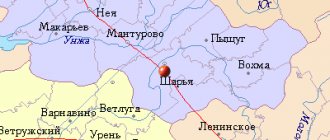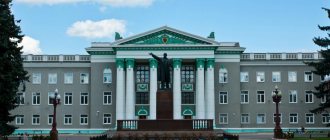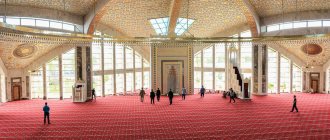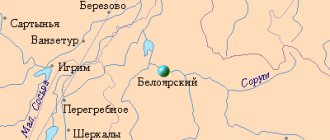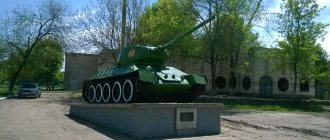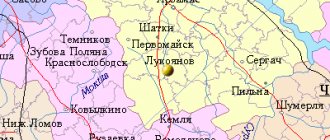About the history of the city of Kizlyar
Kizlyar is one of the most ancient cities of the Republic of Dagestan. A small settlement existed on this territory many years ago, approximately from the 16th century. However, the official founding date of the city is considered to be 1735, when a fortress of the Russian army was built in this area. In 1722, the town was visited by Tsar Peter I during his Persian campaign.
From its very beginning it was a cosmopolitan city. Its founders are considered to be merchants - Tajiks from Central Asia. This place at the crossing of the Terek served as a transit point and inn for trade caravans and foreign embassies. Armenians, Georgians, Persians, Kumyks, Kabardians and Ossetians settled there. And after the construction of the fortress and the founding of a permanent garrison - Russians and Cossacks.
At the beginning of the 19th century, the majority of its population began to be Armenians. In 1807, the Russian government began to develop sericulture and viticulture in Kizlyar. The first vines that made up a small grape plantation were brought from the banks of the Rhine. In the 1840s, there was no longer a need for the military fortress of Kizlyar, and it was gradually eliminated.
In 1880, the now famous Kizlyar Cognac Factory opened its doors. Its founder was the outstanding Russian entrepreneur, scientist and philanthropist, graduate of St. Petersburg University David Sarajishvili (Sarajev). At the same time, at the end of the 19th century, due to the displacement of important trade routes, the emergence and development of new cities, Kizlyar lost its significance as an important city in the North Caucasus and turned into a provincial city. By the beginning of the revolutionary upheavals of 1917-1920. active business life in it completely died down, and the population was reduced by almost half. In particular, almost all the Armenians left.
City coat of arms
The city received a new impetus for development in the 1950s, when the territory to the right of the Terek River, which had previously been practically uninhabited, began to be intensively developed and populated. Now it makes up half of the city’s territory: there is an extensive private sector and a large modern microdistrict “Cheryomushki”. Kizlyar is an important railway junction of Dagestan.
Passenger trains regularly run through its station, connecting Moscow, Tyumen, Volgograd with Makhachkala and Grozny. In Kizlyar there are branches of the Dagestan State University and the Dagestan State Technical University, a medical school, a pedagogical college, and an electro-mechanical college.
During Soviet times, the city grew significantly, expanding no less than 6 times. The most active construction was carried out in the 60-80s of the 20th century. From former country roads, modern streets and highways arose, such as Victory Street, on which a beautiful modern Palace of Culture was opened in 1981.
Time washes away the features of the distant past. There are few interesting ancient buildings and structures preserved in Kizlyar. But they are on Lenin and Sovetskaya streets, which are actually included in the park complex. These are the houses of merchants, famous winemakers, and administrative buildings of the late 19th / early 20th centuries.
Akhtyn Fortress
The Akhtynskaya fortress was built in 1839. It took only 40 days to build it. This was the mainstay of the Russian military positions. Its arsenal consisted of 11 cannons and 6 Kagorn mortars.
What has this fortress not survived? They wanted to capture her, but it didn’t work out. In 1920, the fortress was turned into a prison and this continued for 10 years. During World War II it served as a boarding school and then became a school.
The Akhtyn Fortress hides the history of many years. It is gradually falling apart, but in the near future they plan to restore it and then turn it into a local history museum.
This concludes the review of “Republic of Dagestan: Attractions”. Photos and descriptions should help you figure it out. Write, have you been to Dagestan, did you like it?
Bagration Museum of Local Lore
The local museum of local history is named after the great Russian commander Peter Bagration, a hero of the Patriotic War of 1812, who was mortally wounded in the Battle of Borodino. The famous general, Suvorov's student and favorite, was born and raised in Kizlyar, and here in 1783 he began his military service - as a private in the Astrakhan infantry regiment, stationed in the city.
Bagration Museum of Local Lore
The local history museum of the city of Kizlyar dates back to 1961. Nowadays it is a branch of the Dagestan State United Historical and Architectural Museum. It is located in an ancient building built in 1913 – the former City Hall. Separate thematic exhibitions are dedicated to the biography of Peter Bagration; life and everyday life of the Terek Cossacks; Russian painting. In total, the collection of the local history museum includes more than 16.5 thousand exhibits.
Address: st. Gorky, 1.
Climate
Kizlyar has a cold semi-arid climate (Köppen climate classification: BSk
).
| Climate data for Kizlyar | |||||||||||||
| Month | Jan | Feb | Mar | Apr | May | Jun | Jul | Aug | Sep | October | But I | December | Year |
| Average high °C (°F) | 1.0 (33.8) | 2.2 (36.0) | 7.3 (45.1) | 16.3 (61.3) | 23.1 (73.6) | 27.7 (81.9) | 30.2 (86.4) | 29.6 (85.3) | 23.9 (75.0) | 16.5 (61.7) | 9.1 (48.4) | 3.7 (38.7) | 15.9 (60.6) |
| Daily average °C (°F) | −2.2 (28.0) | −1.3 (29.7) | 3.5 (38.3) | 11.1 (52.0) | 17.8 (64.0) | 22.4 (72.3) | 25.1 (77.2) | 24.3 (75.7) | 18.8 (65.8) | 12.0 (53.6) | 5.7 (42.3) | 0.9 (33.6) | 11.5 (52.7) |
| Average low °C (°F) | −5.7 (21.7) | −4.3 (24.3) | −0.3 (31.5) | 6.0 (42.8) | 12.5 (54.5) | 17.1 (62.8) | 20.0 (68.0) | 19.0 (66.2) | 13.8 (56.8) | 7.6 (45.7) | 2.4 (36.3) | −1.9 (28.6) | 7.2 (44.9) |
| Average precipitation mm (inches) | 17 (0.7) | 19 (0.7) | 20 (0.8) | 31 (1.2) | 39 (1.5) | 47 (1.9) | 28 (1.1) | 23 (0.9) | 30 (1.2) | 31 (1.2) | 28 (1.1) | 21 (0.8) | 334 (13.1) |
| Source: Climate-Data.org [15] | |||||||||||||
Museum of Contemporary History of the City of Kizlyar
It was opened on the eve of the 270th anniversary of the city, in 2005. Its exhibitions highlight the history of the post-war period in the life of the city. They represent all enterprises, institutions, organizations, honored people of Kizlyar who contributed to the development and formation of the city. Within the walls of the museum, together with the city schools, ceremonies are held to present passports to newly minted 14-year-old citizens of the Russian Federation. In the museum you can see a solid collection of awards and their exact copies - from the time of Peter I to the present day. The total number of exhibits in the museum is more than five thousand.
Museum of Contemporary History of the City of Kizlyar
Address: st. Uritsky, 1.
Agrakhan Bay
Agrakhan Bay is located in the western part of the Caspian Sea. The bay separates the Agrakhan Peninsula. Its approximate width ranges from several hundred meters in the North to ten kilometers in the South.
Today, the bay is divided into two parts, which are isolated from one another by the bed of the Terek River. The northern part has a connection with the Caspian Sea, and a lake has practically formed from the southern part. The northern part of the bay has desalinated water, while the southern part has fresh water. Agrakhan Bay is one of the most famous places where a large number of different birds nest.
Museum of History and Culture of the Terek Cossacks
The Cossack Museum has been operating in Kizlyar since 2007. The presented exhibitions demonstrate the life and everyday life of the Cossacks, their traditional crafts: fishing and hunting, pottery, carpet weaving. Various examples of festive and everyday clothing are presented, and the decoration of the upper room in the Cossack kuren is recreated. Separate exhibitions are dedicated to Russian folk arts and Orthodoxy.
Address: st. Sovetskaya, 17.
Kizlyar Brandy Factory Museum
A visit to this museum is the final part of an interesting tour of the plant, which became the founder of cognac production in Russia. Tourists are guided step by step through the workshops of the enterprise: wine materials workshop; hardware (distillation); aging shop; blending shop and bottling shop. Guests are shown the laboratory and, of course, the richly decorated tasting room. The museum displays awards won by Kizlyar cognacs at various international exhibitions; bottles with products from previous years (the oldest is from 1936) and all samples of modern products. Nowadays, the plant remains the official supplier of the Kremlin, and at protocol events, 15-year-old Rossiya cognac, made in Kizlyar, is placed on the tables.
Aging workshop of the Kizlyar Brandy Factory
Address: st. Ordzhonikidze, 60.
Central Park
Nothing has survived from the serious fortress of Kizlyar, which was an outpost of the Russian Empire in the Caucasus. In addition to some rarities that are kept in museums of the city and the Republic of Dagestan. Now on the site of the fortress there is an excellent Petrovsky Park, which has existed since the 60s of the 19th century. It is at this historically significant place that the Bagration Museum, several monuments and memorials are located, as well as a whole complex of cultural, sports and children's facilities, which together make up a favorite place of leisure for Kizlyar residents and guests of the city. The Peter the Great Park best conveys the general impression of the city and much of its long history.
Central Park
In 1960, at the intersection of two central historical streets - Lenin and Sovetskaya (Gimnazicheskaya and Bolshaya - in tsarist times), the main entrance arch was built. A bust of Peter I was installed right in front of her.
Pushkinsky Square
The square is located near Central Park, on Sovetskaya. A monument to the world-famous Russian poet Pushkin was placed in the park, which is why the park was named Pushkinsky. Next to the park there is a local history museum.
The square is not very big, but quite green. There are many flower beds decorated with various flowers. A semicircular pedestal was also installed. This pedestal is decorated with paintings depicting everyday scenes from the 18th - 19th centuries. The park is very cozy and always pleasant to relax.
Monument in honor of the 250th anniversary of the founding of the Kizlyar fortress
This monument in Central Park is dedicated to a lost fortress that once played a huge role in the North Caucasus. Its commandant was considered the “boss” of the entire space from the Caspian to the Azov seas. It is not for nothing that the date of the founding of the fortress became the date of the founding of the city. The monument is dedicated to all Russians and Cossacks who laid the foundation for the city. However, the heroes of the sculptural composition were a worker, who raised his hammer and sickle high above his head, and a collective farmer, who simply raised her palm up, as if voting. This is not surprising, because the monument was erected in the Soviet era: in 1985, on the occasion of the 250th anniversary of Kizlyar.
Monument in honor of the 250th anniversary of the founding of the Kizlyar fortress
Address: st. Pervomayskaya, 2.
Walk of Fame and Memory Monument
The Walk of Fame is located in the Central Park of the city of Kizlyar, and continues the architectural ensemble of its entrance arch, from Pervomaiskaya Street. The alley was founded in memory of Soviet soldiers who gave their lives during the Civil and Great Patriotic Wars. Previously, in its place there was a parade ground for Russian soldiers and officers who served in the Kizlyar fortress.
The main part of the memorial is the “Memory” monument - a sculptural composition depicting a cavalry rider and infantry soldiers; as well as a stone pantheon with the names of fellow countrymen who died in the Civil and Great Patriotic Wars. In 2012, here in memory of the Patriotic War of 1812, in which the Terek Cossacks took part along with the great Bagration, a large memorial stone was erected on the marble steps. Flower beds, plantings, and alleys converge at the arch with the sculpture of the Goddess of Victory. If you look from above, you get the appearance of a rocket. This is a symbolic reflection of the history of the city of Kizlyar through wars and sacrifices - to the future.
Administrative and municipal status
As part of the structure of administrative units, Kizlyar serves as the administrative center of Kizlyar District, even though it is not part of it.[1] As an administrative division, together with one urban settlement (Komsomolsky) and one rural area (loop railway crossing No. 17), included separately as Kizlyar Town
- an administrative unit with a status equal to that of a district.[1]
As a municipal entity, Kizlyar is registered as Kizlyar City Okrug
.[4]
Memorial to victims of terrorist attacks in Kizlyar
On January 9, 1996, sabotage groups of Chechen terrorists committed an inhumane war crime in Kizlyar. They repeated the June 1995 raid on the city of Budyonnovsk: they took a large number of hostages and locked themselves in the building of the city hospital. And then, hiding behind them as a human shield, they went on buses to the territory of Chechnya. 78 people died. A monument with the mournful face of a crying mother is dedicated to the memory of these victims. On March 31, 2010 and February 18, 2022, two more terrorist attacks were committed in Kizlyar. In the first case, 12 people died from two explosions; in the second, five people (all women) died from shooting at parishioners of an Orthodox church with a hunting rifle at the hands of an Islamic terrorist.
Demography
Kizlyar population
| 2010 Census | 48,984[2] |
| 2002 Census | 48,457[11] |
| 1989 Census | 39,748[12] |
| 1979 Census | 31,320[13] |
As of the 2002 Census, the ethnic composition of the city was as follows:[14]
- Russians (48.6%)
- Avars (15.4%)
- Dargins (11.7%)
- Kumyks (5.0%)
- Lezgins (4.0%)
- Laks (3.2%)
- Azerbaijanis (1.8%)
- Nogais (1.4%)
- Tabasarans (1.3%)
- Rutuls (1.3%)
- Chechens (1.1%)
Monument to Pyotr Ivanovich Bagration
The poor house in which the Russian commander was born and raised has not survived. Approximately at the place where he was located, a memorial to an outstanding fellow countryman was erected in Kizlyar. It consists of a large and massive bust of the general, mounted on a high pedestal, and an extensive stand at the back of the monument, with paintings from his biography. The brave warrior was Georgian by nationality; was born and raised on Dagestan soil, and in spirit and worldview he always considered himself Russian.
Monument to Pyotr Ivanovich Bagration
Location: intersection of Kirov and Bagration streets.
Monument to V.I. Lenin
Vladimir Ilyich Lenin is a statesman. In the city of Kizlyar, two monuments were erected to Vladimir Ilyich.
One monument is located on the territory of the city Central Park next to Pushkin Square. Another monument can be seen next to Bagration Square, in Levashov Square.
The monument to Vladimir Ilyich Lenin stands on a stone dais. The pedestal is installed on a square platform, which is lined with stone tiles. The monument was made in full height.
Religious sites
In Kizlyar there is the Cathedral Church of St. George the Victorious (built in 1995), as well as the Temple of St. Nicholas the Wonderworker (built in 1795) assigned to it, located in the cemetery, as well as the Holy Cross Convent with a temple in honor of the icon of the Mother of God “Recovery of the Lost” (1735- 1918, revived in 2007).
A spiritual and educational center was organized at the Council, at which a library of Orthodox literature was created; a Sunday school with about 150 children, and a charity refectory.
Address of St. George's Cathedral: st. Sovetskaya, 14.
St. George's Cathedral in Kizlyar
St. Nicholas Church at the Orthodox cemetery became the only temple that survived the years of Soviet power. It also runs a Sunday school.
Address of the Church of St. Nicholas the Wonderworker: st. Radishcheva 17.
The Holy Cross Convent is the same age as the city: it was founded in 1735, shortly after the creation of the Kizlyar fortress. True, the monastery was for men. It was repeatedly attacked by mountaineers, was ruined by them, but was revived again. In 1908, the monastery was converted into a convent. During the civil war it was liquidated and looted. It was revived only in 2007.
Location of the monastery: st. Road, next to the Orthodox cemetery.
The central mosque of Kizlyar is dedicated to the 200th anniversary of Imam Shamil. In April 2015, as a result of a fire, it was completely burned out from the inside. But it was rebuilt within a year and opened in the summer of 2016. At the southern entrance to the city, on Gamidov Street, there is another new mosque. And in the Cheryomushki microdistrict, on Tsiolkovsky Street, since 2016, construction has been underway on a huge mosque that can accommodate up to twenty thousand parishioners at a time. This mosque has three floors (18 meters), four minarets 21 meters high and a main dome.
Lake Kezenoyam
Lake Kezenoyam was formed a long time ago. When a mountain collapse occurred, a gigantic dam appeared and a lake overflowed not far from the place where two rivers connected. Today, most of the lake is located on the territory of the Dagestan Republic, and the rest belongs to the Chechen Republic.
The lake has an azure hue, and the water in it is quite cold. Even in summer, when it is unbearably hot outside, the temperature in the lake rises to a maximum of 18 degrees. In winter, the lake is covered with ice, the thickness of which is 80 cm. The nature on the lake is so beautiful that tourists from all over the world come there.
Do you love the beach and the sea? Then you should go to Feodosia.
